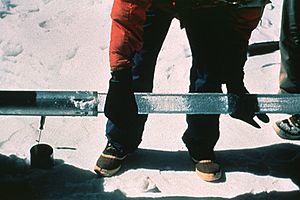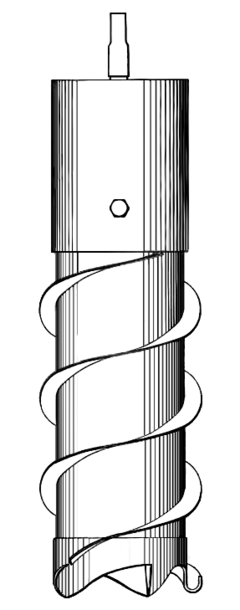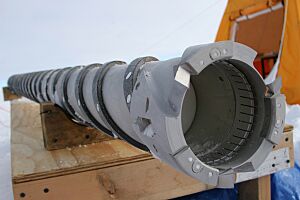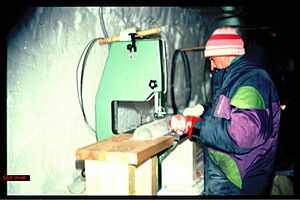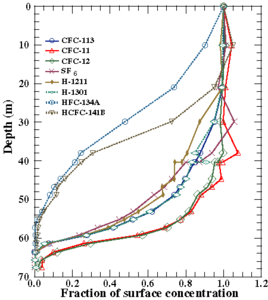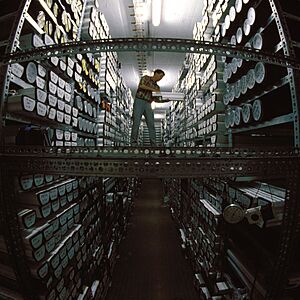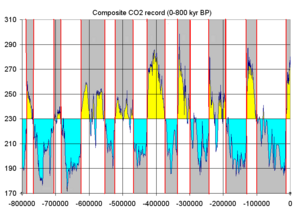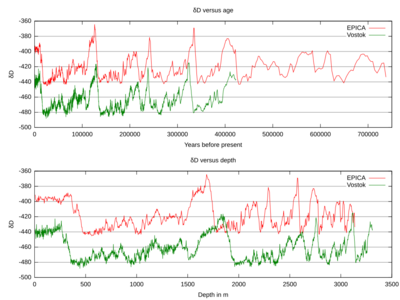Ice core facts for kids
Imagine a giant frozen timeline of Earth's history! That's what an ice core is. It's a long cylinder of ice taken from huge ice sheets or tall mountain glaciers. Think of it like a stack of pancakes, where each pancake is a year's snowfall. The deeper you go, the older the ice.
Scientists drill these cores using special tools. Some are simple hand drills for shallow ice, while others are powerful machines that can go over two miles (3.2 km) deep! These deep cores can hold ice that is up to 800,000 years old. That's a lot of history!
By studying the ice and tiny things trapped inside, like air bubbles and dust, scientists can learn about Earth's climate long ago. They can find out about ancient temperatures and even what the air was like. This helps us understand how our planet has changed over time.
Ice cores also contain clues about big events. For example, dust from strong winds or ash from powerful volcanoes can be found in specific layers. Even tiny traces of radioactivity from natural sources or past activities can help scientists figure out the exact age of different ice layers.
People started studying ice cores in the early 1900s. Big projects, like those during the International Geophysical Year (1957–1958), helped drill deeper than ever before. Today, scientists continue to explore ice sheets in places like Antarctica and Greenland to uncover more of Earth's frozen past.
Contents
Discovering Earth's Past with Ice Cores
How Ice Cores Form and What They Show
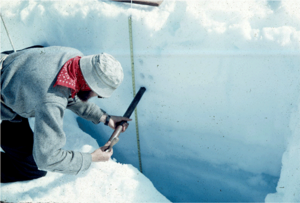
An ice core is like a vertical timeline through a glacier. It shows layers of snow that fell year after year. As new snow piles up, it presses down on the older layers. This makes the snow denser, turning it into something called firn.
Firn is like very packed snow. It still has tiny air pockets that can let air escape. But when the firn gets even denser, it turns into solid ice. At this point, any air trapped inside gets sealed into tiny bubbles. These bubbles are like mini time capsules, holding samples of the ancient atmosphere!
The depth where firn turns into ice changes depending on the location. In Greenland and Antarctica, it's usually between 64 and 115 meters deep. The age of the ice when it seals the air can vary a lot too. For example, at Summit Camp in Greenland, the ice is about 230 years old when the air is trapped. But at Dome C in Antarctica, it can be 2500 years old!
As the ice gets even deeper, the pressure becomes enormous. Around 1500 meters down, the ice crystals actually change their shape. This allows air molecules to move into the crystals, and the bubbles disappear. The ice then becomes clearer.
What Impurities Tell Us
The ice layers also contain tiny bits of other materials, called impurities. These impurities are like clues about the environment from long ago. They can include soot and ash from forest fires or volcanoes. Scientists also find tiny micrometeorites, pollen, and even special isotopes created by cosmic rays.
The very bottom layer of a glacier is called basal ice. It's often made of melted water that refroze under the glacier. While it can hold interesting things like tiny living organisms, it often doesn't keep clear layers of information.
In places like Antarctica and central Greenland, it's almost always freezing cold. But even there, summer sunlight can change the snow. The sun can make some snow disappear into the air (a process called sublimation). This leaves the top layer less dense.
When the sun is low in the sky, the temperature drops, and hoar frost forms. This coarse, icy frost gets buried by new snow. It compresses into lighter layers compared to the winter snow. This is why you can sometimes see alternating light and dark bands in an ice core, showing the different seasons.
Getting the Ice Cores: Drilling Methods
Scientists collect ice cores by cutting a cylinder of ice and bringing it to the surface. For shallow holes, they often use hand augers. These tools are like a cylinder with spiral metal blades on the outside. The blades cut into the ice as the auger is rotated.
Simple Hand Augers
Hand augers can be turned with a handle or even attached to an electric drill. With a special stand called a tripod to help lower and raise them, these augers can collect cores up to 50 meters deep. However, for deeper ice, more advanced drills are needed.
Deep Drilling Techniques
For very deep holes, scientists use powerful electromechanical or thermal drills. The cutting part of the drill is at the bottom of a long tube called a drill barrel. This barrel surrounds the ice core as the drill cuts downwards.
As the drill cuts, it creates ice chips, called cuttings. These chips must be removed from the hole so the drill can keep working efficiently. They can be pushed into the walls of the hole, or air can be used to blow them out. For the deepest holes, a special liquid called drilling fluid is used.
Dry drilling (using air) only works for depths up to about 400 meters. Below that, the immense weight of the ice above would cause the hole to close up.
Special Drilling Liquids
Drilling fluids are important for deep holes because they balance the pressure and keep the hole stable. The fluid needs to be thin so that the drilling equipment can be pulled out and put back quickly. This is important because retrieving each section of core takes a lot of time. A slow fluid could add a year or more to a deep drilling project!
The fluid also needs to be safe for the environment and not contaminate the ice. It should be affordable and easy to transport to remote locations. Historically, scientists used mixtures of kerosene-like products and other chemicals. Today, new types of fluids are being developed, including those based on plant oils.
Different Drill Types
One common method is rotary drilling, where a long string of pipes is rotated from the top. Drilling fluid is pumped down and back up, carrying the ice chips. However, this method takes a long time because the entire pipe string must be removed and reconnected for each core section.
A better method for ice is using wireline drills. With these, the core barrel can be pulled up to the surface while the rest of the drill stays at the bottom of the hole. This saves a lot of time. Another option is flexible drill-stem rigs, where the drill string can coil up at the surface, avoiding the need to disconnect pipes.
Many modern drills are suspended on a strong cable that also provides power to the motor at the bottom. These cable-suspended drills are very reliable for deep ice drilling. They need special devices to stop the drill from spinning around as it cuts the core. The ice chips are usually stored in a chamber in the drill and emptied when the core is brought up.
Thermal drills use electricity to heat the drill head and melt the ice. They can be useful in certain conditions, but they use a lot of power. The heat can also damage the ice core. Hot-water drills use jets of hot water to melt the ice around the core. However, it's hard to control the hole's size, and the heat can shock the core.
When drilling very deep holes, the upper part of the hole, which goes through snow and firn, needs a cylindrical lining called casing. This stops the drilling fluid from being absorbed.
Scientists have also developed ways to drill "replicate cores." These are extra cores taken from the side of the main borehole at interesting depths. This helps ensure there are enough samples for all the different scientific studies.
Handling and Storing Ice Cores
After drilling, several important steps happen before an ice core is stored.
Careful Core Processing
A special lever called a core dog breaks off the core and holds it as it's brought to the surface. The core is then carefully slid out of the drill barrel onto a prepared surface. It must be cleaned of drilling fluid, sometimes using a vacuum system. The surface must be perfectly aligned to prevent the core from breaking, as ice is very fragile. The area is kept extremely cold to avoid any sudden temperature changes.
Scientists record important details about each core, like its length and depth. The core is often marked to show its original direction. It's usually cut into shorter sections, often one meter long. These sections are stored at the drill site, usually underground, to keep them cold. Any samples needed for early analysis are taken.
Finally, the core sections are placed in bags, often made of plastic, and packed with padding for shipment. When flown out, the aircraft's cargo area is kept unheated. If transported by ship, they are kept in special refrigeration units.
There are several places around the world that store ice cores, like the National Ice Core Laboratory in the US. These facilities make samples available for scientists to study. A large part of each core is saved for future research.
Dealing with Brittle Ice
At certain depths, called the brittle ice zone, air bubbles are trapped in the ice under huge pressure. When the core is brought to the surface, this pressure can cause the ice to crack or shatter. Deeper down, the air forms tiny structures called clathrates, and the ice becomes stable again. At one site, the brittle ice zone was found between 520 and 1340 meters deep.
Cores from the brittle ice zone are often of poorer quality. To help, scientists can use liners inside the drill barrel to hold the core together. Keeping the processing areas very cold also helps prevent thermal shock. Sometimes, cores are broken into shorter lengths while still in the hole. Allowing brittle cores to rest in storage for a long time, even a year, helps the ice gradually relax.
Unlocking Secrets: What Ice Core Data Reveals
Scientists perform many different tests on ice cores. They count layers, measure electrical conductivity, and analyze gases, particles, and chemicals. To understand the past, they need to know the age of each ice layer.
Dating the Ice Layers
The simplest way to date ice is by counting the annual layers of snow, like tree rings. But this isn't always possible. Another way is to use computer models to predict how long it takes for snow to reach a certain depth. Scientists can also match radioactive elements or trace gases in the ice to known events or cycles in Earth's orbit.
One challenge is that gases can move through firn. So, the air trapped in the ice might be younger than the ice itself. Scientists use models to figure out this age difference. In places with very little snowfall, like Vostok Station, this difference can be over 1,000 years.
The size and number of bubbles in the ice can also tell us about past temperatures. This is because crystal growth depends on temperature.
Radiocarbon dating can be used on the carbon in trapped carbon dioxide (CO2). Scientists carefully separate the CO2 from the ice. They must also account for carbon-14 (14C) created by cosmic rays in the ice.
Volcanic eruptions that spread ash globally leave a distinct mark in ice cores. These layers act as "marker horizons" that help scientists match up the timelines of different cores. For example, the 1815 eruption of Mount Tambora can be found in both Greenland and Antarctic ice cores. If the eruption date is known, it helps date the ice. If not, dating the ice can help date the eruption!
The boundary between the Pleistocene and Holocene periods, about 11,700 years ago, is now officially defined using data from Greenland ice cores. This helps scientists worldwide compare their findings.
Ancient Air in Bubbles

Scientists realized in the 1960s that studying the air trapped in ice cores could reveal much about the paleoatmosphere (ancient atmosphere). By the late 1970s, they had a reliable way to extract this air. Early studies showed that carbon dioxide (CO2) levels were 30% lower during the Last Glacial Maximum compared to before the industrial age. Further research confirmed a strong link between CO2 levels and past temperatures.
Methane (CH4) in the atmosphere is linked to the strength of monsoons. Monsoons are affected by Earth's orbital cycles, which have a known timeline. So, methane can help date ice cores. Nitrous oxide (N2O) levels also follow glacial cycles. Even the ratio of nitrogen (N2) to oxygen (O2) in trapped air can help date cores, as it reflects past summer sunlight.
Other changes in the firn layer can also be measured. Heavier molecules tend to settle at the bottom of a gas column, especially in colder temperatures. By measuring these changes in trapped air, scientists can learn about the thickness of the firn layer and past ocean temperatures. Some gases, like helium, can quickly escape from ice. So, they must be tested soon after the core is retrieved.
Chlorofluorocarbons (CFCs), which contribute to the greenhouse effect and harm the ozone layer, can be found in ice cores from after about 1950. Almost all CFCs in the atmosphere were made by humans.
Chemical Clues in the Ice
Summer snow in Greenland contains more sea salt from the surrounding waters than winter snow. Also, hydrogen peroxide appears only in summer snow because it needs sunlight to form. These seasonal changes can be detected by measuring the electrical conductivity of the ice. By dragging electrodes along the core, scientists can create a graph that shows annual patterns.
These graphs also reveal chemical changes from non-seasonal events, like forest fires and major volcanic eruptions. If a known eruption, like the 1783 eruption of Laki in Iceland, is found in an ice core, it helps confirm the age of the ice layers. Material from Laki was found in Greenland cores, but not in Antarctica. However, the 1815 eruption of Mount Tambora reached both poles.
Many other elements and molecules have been found in ice cores. In 1969, scientists discovered that lead levels in Greenland ice had increased over 200 times since before the industrial age. Increases in other elements from industrial processes, like copper, cadmium, and zinc, have also been recorded. The presence of lead in Greenland ice cores has even been linked to periods of war and mining during the Roman Empire.
Nitric and sulfuric acid (HNO3 and H2SO4) in precipitation show a link to increasing fuel combustion over time. Methanesulfonate (MSA), produced by marine organisms, gives clues about the history of the ocean. Hydrogen peroxide (H2O2) and formaldehyde (HCHO), along with carbon black from vegetation and fires, have also been studied. Some chemicals, like calcium and ammonium, show strong seasonal changes.
| Source | Via | Measured in polar ice |
|---|---|---|
| Oceans | Waves and wind | Sea salt: Na+, Cl−, Mg2+, Ca2+, SO2− 4, K+ |
| Land | Aridity and wind | Terrestrial salts: Mg2+, Ca2+, CO2− 3, SO2− 4, aluminosilicates |
| Human and biological gas emissions: SO2, (CH3)2S, H2S, COS, NOx, NH3, hydrocarbons and halocarbons | Atmospheric chemistry: O3, H2O2, OH, RO2, NO3, | H+, NH+ 4, Cl−, NO− 3, SO2− 4, CH3SO− 3, F−, HCOO−, other organic compounds |
Traces of Radioactivity
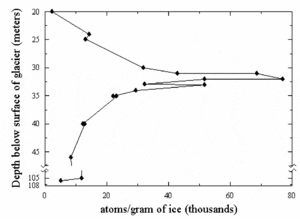
Galactic cosmic rays create Beryllium-10 (10Be) in the atmosphere. The amount of 10Be depends on the sun's magnetic field, which is linked to solar radiation. So, 10Be levels in ice cores can show past solar activity. Scientists can detect tiny amounts of 10Be, about 10,000 atoms in a gram of ice.
Tritium (3H), created by nuclear weapons testing in the 1950s and 1960s, has been found in ice cores. Other radioactive elements like Chlorine-36 (36Cl), Krypton-85 (85Kr), Lead-210 (210Pb), and Silicon-32 (32Si) are also used to date ice layers.
Other Amazing Discoveries
Meteorites and micrometeorites that land on polar ice can sometimes be concentrated by natural processes. For example, winds in Antarctica can evaporate surface ice, leaving behind solids like meteorites. Meltwater ponds can also collect them. At the South Pole Station, micrometeorites are collected from melted ice used for water supply. Since the age of the melted ice is known, scientists can determine the age of these tiny space rocks.
Pollen, which is very important in sediment cores, is also found in ice cores. It provides valuable information about how vegetation has changed over time.
Physical Properties
Besides impurities and the water's isotopic makeup, the physical properties of the ice itself are studied. Features like crystal size and how the crystals are aligned can reveal how the ice sheet has flowed over time. Crystal size can also help date shallow cores.
A Brief History of Ice Core Science
The first attempts to drill into glaciers happened in the 1840s in the Alps, but these didn't produce cores. In the early 1900s, scientists started creating tools to sample snow. James E. Church, known as "the father of modern snow surveying," built steel tubes to collect snow cores up to 3 meters long. Similar tools are still used today.
Systematic studies of snow layers began in the 1930s in Greenland. In the 1950s, several expeditions started ice coring, though the quality of the early cores was not great.
The International Geophysical Year (1957–1958) greatly boosted glaciology research. Scientists drilled pilot holes in Greenland, reaching over 400 meters deep. In Antarctica, cores were drilled at Byrd Station and Little America V. This success led to even deeper drilling projects. In the 1960s, a project at Camp Century in Greenland reached the bottom of the ice sheet at 1387 meters. The same drill was then used at Byrd Station, reaching 2164 meters.
French, Australian, and Canadian projects in the 1960s and 1970s also drilled deep cores in Antarctica and on the Devon Ice Cap.
Deep Cores in Antarctica
Soviet ice drilling projects began in the 1950s in various locations, including Vostok Station in Antarctica. Deep drilling at Vostok started in 1970. By 1985, Vostok 3 reached 2202 meters, retrieving ice from the previous glacial period, 150,000 years ago. A later Vostok core, started in 1990, reached 3769 meters. The ice at 3310 meters was estimated to be 420,000 years old.
In the 1990s, a European collaboration called EPICA drilled two deep holes in East Antarctica. One at Dome C reached bedrock at 3260 meters. This core had very low snowfall rates, meaning its climate record went back a very long time—up to 800,000 years ago.
Other deep Antarctic cores include Japanese projects at Dome F, reaching ice estimated to be 720,000 years old. US teams drilled at McMurdo Station, Taylor Dome, and Siple Dome. The West Antarctic Ice Sheet (WAIS) project, completed in 2011, reached 3405 meters. This core provides detailed data for the last 62,000 years due to high snow accumulation.
In 2016, cores from the Allan Hills in Antarctica were found to contain ice from 2.7 million years ago. This is by far the oldest ice ever dated from a core!
Deep Cores in Greenland
The Greenland Ice Sheet Project (GISP) began in 1970. After years of searching for the best spot, a deep core was drilled at Dye 3, reaching 2037 meters in 1981. In the early 1990s, two groups, GRIP (European) and GISP-2 (US), drilled two holes about 30 km apart in north-central Greenland. Both reached bedrock, providing about 100,000 years of climate information.
Because of the underlying rock, a new site was chosen further north for the NorthGRIP. Drilling began in 1996, and a new hole started in 1999 reached 3085 meters in 2003. This core provided climate data going back 123,000 years. The NEEM project followed, retrieving a 2537-meter core in 2010, extending the record to 128,500 years ago. The EastGRIP project, which started in 2015, continued drilling in east Greenland. The 2020 field campaign was cancelled due to the COVID-19 pandemic, but EastGRIP reopened for field work in 2022.
Cores from Other Regions
Ice cores have also been drilled outside the polar regions, especially in the Himalayas and the Andes. These cores are important for understanding events like El Niño and monsoon seasons in South Asia. Cores have also been taken from Mount Kilimanjaro, the Alps, and in many other countries.
Looking to the Future of Ice Core Research
The IPICS (International Partnerships in Ice Core Sciences) group has outlined future goals for ice core science. These include:
- Finding ice cores that go back over 1.2 million years to study older climate cycles.
- Improving how ice core timelines are matched up.
- Discovering new clues in ice cores, such as for sea ice, ocean life, or forest fires.
- Drilling more cores to get detailed climate data for the last 2,000 years.
- Developing better drilling fluids and ways to handle brittle ice.
- Creating a standard, lightweight drill that can reach depths of up to 1000 meters.
- Improving how cores are handled to get the most information from each one.
Scientists have found that a warming climate causes glaciers to melt. This washes away the layers of trapped aerosols that researchers use as historical records. To protect this data, the Ice Memory Foundation plans to store additional ice cores in Antarctica.
See also
 In Spanish: Testigo de hielo para niños
In Spanish: Testigo de hielo para niños
- List of ice cores
- Ice drilling


